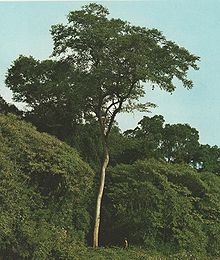Dyer's mulberry tree
| Dyer's mulberry tree | ||||||||||||
|---|---|---|---|---|---|---|---|---|---|---|---|---|

Blackberry Tree ( Maclura tinctoria ), illustration |
||||||||||||
| Systematics | ||||||||||||
|
||||||||||||
| Scientific name | ||||||||||||
| Maclura tinctoria | ||||||||||||
| ( L. ) D. Don ex Steud. |
The blackberry tree ( Maclura tinctoria ) is a species of the mulberry family (Moraceae). The blackberry tree is native to Mexico and Central America , the Antilles and tropical South America (southern Brazil) and temperate South America.
description
The dyer's mulberry tree is a tree or shrub that reaches heights of growth of up to 20-30 meters or more and a trunk diameter of 60-70 centimeters or more. It contains milky sap and there may be sharp thorns . Larger roots are often formed. The bark is relatively smooth and gray-brown.
The alternate, papery-leathery and short-stalked leaves are simple with a whole to, partly coarse, serrated to lobed leaf margin. They are elliptical to ovate or obovate, rounded. At the top they are pointed or pointed to pointed, tailed. The small stipules are sloping.
The dyer's mulberry tree is dioeciously separated sexes ( dioecious ). The stalked male, axillary and many-flowered, green-yellow, walzlichen inflorescences are eared and often appear singly or up to four. They are up to about 10-12 centimeters long. The stalked female, round and multi-flowered, white-green heads are axillary and usually appear individually. They are about 8-12 millimeters in size. The mostly unisexual and sedentary flowers are usually four- sometimes five-fold with a simple flower cover. There are in the flowering each one to several, glands occupied and hood-shaped 1-2 mm long bracts present. The male flowers have a small pestle and the 1.5 millimeter long tepals have no glands. The female flowers, the 3-millimeter-long tepals are usually occupied glands and the white pen is long and above with tapering, long filamentous scar . The ovary is on top of the flower base .
In each case stone fruits are formed which stand together in a 1.5–2.5 centimeter fruit cluster ( false fruits ). The yellow, fleshy and sweet fruits are edible. The elliptical stone core is flattened and about 3–4 millimeters long.
use
The heartwood of the trunk is yellow and is sold under the name yellowwood . Other names are real yellow wood, Cuban, Brazilian wood, Brazilian yellow wood, yellow Brazilian wood, Dutch yellow wood, old or real fustik, fustic wood. As well as was also named after the origin; Jamaica, Nicaragua, Cuba, Tampico, Domingo or Portorico yellow wood u. s. w.
The name “dyer's mulberry tree” goes back to the use of yellow wood for dyeing . The yellow wood used to be sold in blocks. Different varieties were offered, which were mainly characterized by the country of origin. The "Nicaragua yellow wood" was considered to be one of the best qualities. From the 19th century its extract was used instead of yellowwood for coloring. In the painting was colored lacquer "yellow wood paint" is used.
Yellowwood contains the dyes morin , a pentahydroxyflavone , and maclurin , a benzophenone dye .
Systematics
The first description of Basionyms Morus tinctoria was made in 1753 by Carl Linnaeus in Species Plantarum 2: 986. The new combination to Maclura tinctoria was made in 1841 by Ernst Gottlieb von Steudel in Nomenclator Botanicus. Editio secunda 2: 87, based on David Don.
A few synonyms , out of many, are: Chlorophora tinctoria (L.) Gaudich. ex Benth. , Broussonetia tinctoria (L.) Kunth , Maclura sieberi Blume u. s. w.
supporting documents
- RC Kaastra: Revision of Chlorophora (Moraceae) in America. In: Acta. Bot. Neerl. 21 (6), 1972, 657–670, online (PDF) at Natuurtijdschriften.nl, accessed on May 19, 2019.
- Wanted poster at Trees, Shrubs, and Palms of Panama . (engl.)
Web links
- Maclura tinctoria at Useful Tropical Plants.
- Maclura tinctoria at Smithsonian Tropical Research Institute.
- Maclura tinctoria (images), at plantsystematics.org, accessed May 20, 2019.
- Entry in DELTA's commercial timbers in the Biology Department: Universität Hamburg.
Individual evidence
- ↑ JL Battilani, EF Santiago, A. Souza: Morphology of fruits, seeds, and seedling and sapling development of Maclura tinctoria (L.) D. Don. ex Steud. (Moraceae). In: Acta Botanica Brasilica. 20 (3), 2006, 581-589, doi: 10.1590 / S0102-33062006000300008 .
- ^ Rainer Bruns: Natural and vegetable building materials: raw material. 2nd edition, SpringerVieweg, 2012, ISBN 978-3-8348-1321-3 , p. 289.
- ↑ Wenzel Brožowsky: Waarenkunde in a systematic presentation of the most important natural and artificial products. Gerold, 1859, p. 247 f.
- ^ Maclura tinctoria at KEW Science.
- ^ The Plant List

